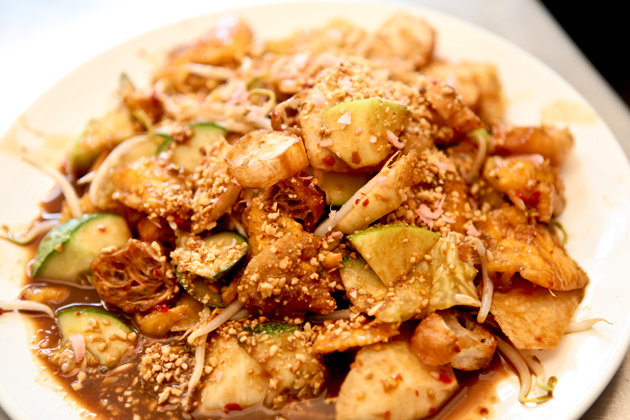
Singapore Rojak Recipe
By Sheere Ng - Tuesday, Dec 27, 2011

Go to a party at someone’s house, and you see food like cereal prawns, fried bee hoon, sweet and sour fish, and cheng teng for dessert. But when it comes to the salad section, the western renditions like waldorf or caesar will often creep into the Asian spread.
What’s wrong with offering our local salad, the ubiquitous rojak?
Some of you may find its flavour too strong to make a good starter. The spicy and piquant flavour of the prawn paste dressing will indeed hinder one’s ability to taste most other food, but this problem takes no more than a quick rinse to solve.
Others are not sure if they can make a good rojak, as they assume that the preparation work to create a taste so complex will be tedious.
Well, rojak requires only a handful of ingredients, all of which are available at most neighbourhood markets. There’s not much preparation to talk about. The fruits and vegetables only need a rinse (turnip however needs a shave) and to be cut into the required size.
What’s perplexing is the taste of the sweet prawn paste, which is made of fermented ground shrimp. To those who don’t understand it, it may even smell disgusting. Yet the chaotic flavour is the winning ingredient that holds everything together
While the taste may be complex, the method of making can’t be any simpler. Anyone who understands the concept of mixing can master it.
You can choose to expand the range of ingredients. For your reference, Penang’s version uses mostly fruits while the Indonesians serve it with slices of bull’s nose and call it Rujak Cingur. Some of our local hawkers are already adding things like green mango and guava.
In a way, rojak which means “a mixture of” in Malay, echoes the multi-ethnicity in the region. Perhaps, to introduce new items to the dish is to truly reflect the even more diverse ethnic makeup in today’s Singapore.
Main ingredients (2 servings)
¼ cucumber
¼ pineapple (you could get the fruit seller to get the greener one for drier and harder texture)
¼ turnip (bangkwang)
1 dough fritter (you char kueh)
80g bean sprout
¼ stalk of ginger flower
½ green apple
Paste
3 tbsp prawn paste (hae kor)
1-2 tbsp sambal chilli
2½ tbsp tamarind juice
1½ tsp sugar
3 tbsp roasted peanuts (crushed)
2 limes
Method:
Blanch the bean sprouts in boiling water for 10 seconds. Drain the water and put it aside.
Wash the apple.
Wash the cucumber. Cut off the tip.
Peel the turnip with a vegetable peeler and clean it with water.
Cut the pineapple, apple, turnip and cucumber into wedges of irregular shapes.
In a mixing bowl, add prawn paste, sugar, sambal and tamarind juice and mix well.
Throw in the fruits and vegetables and gently fold in the sauce. Make sure you do not press on the fruits to avoid drawing wanted moisture.
Transfer it onto a serving plate.
Slice the ginger flower into tiny bits and sprinkle over the mixture.
Zest the lime over the mixture
Sprinkle peanuts and squeeze 1tbsp of lime and you’re done!
Taste note: The accent of hae kor shines through, but calmed by the sweet and sour taste of sugar, lime and tamarind. The ginger flower lends a floral flavour while the peanuts give it an earthy texture. It is chaotic in texture and flavour.


